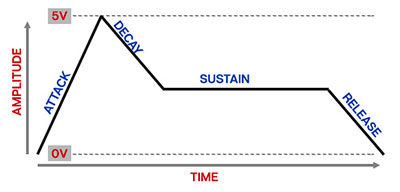
Like the original Jupiter-6, Mercury-6 includes two ADSR envelope generators. Envelope 2 is mostly dedicated to controlling note amplitude; Envelope 1 generally controls filter cutoff frequency, but both include few additional modulation routings. Before we get into their controls, let's review the operation of an ADSR envelope.
How An ADSR Envelope Generator Works

When Mercury-6 sees a gate voltage from a note, the envelope generator outputs a dynamically changing voltage, according to the settings of its four stages. The attack stage defines how long it takes for the output voltage to rise from zero to maximum. Once the attack stage reaches maximum level, it moves to the decay phase, which defines how long it takes to fall from max to the setting of the sustain phase. Unlike the attack, decay, and release phases, which define times, sustain simply sets the held voltage level following the attack and decay phases - this equates to the envelope output level while holding down a key. Finally, the release slider defines the the length of time it takes for the voltage to fall back to zero when the gate input voltage is removed, i.e. when the key is released.
Envelope 1

Envelope 1 is mainly intended to control filter cutoff frequency, but it also can be routed to control oscillator pulse-width modulation.
Pol (polarity) buttons- The top button puts Env-1 in positive mode, that is voltages will start at zero and move up to +5V internally. When used to modulate a parameter, this equates to moving a slider upward. When the bottom button is selected (i.e. inverted), voltages start at 0V and move toward -5V internally, which will have the effect of turning a slider down when a parameter is modulated.
Attack- Defines the length of time for voltage to rise from zero to maximum when a key is played.
Decay- Defines the length of time for voltage to fall from the attack stage peak to sustain stage setting.
Sustain- Sets the voltage level following attack and decay phases while a note is held.
Release- Defines the length of time for voltage to fall from sustain level to zero when a key is released.
Vel (Velocity)- Allows keyboard velocity to control the overall output level of the envelope generator. Increasing the amount adds sensitivity with lightly played notes outputting less voltage. This control wasn't present on the original Jupiter-6, as it didn't have a velocity-sensitive keyboard, but since almost every modern controller transmits velocity, we added it.
Key Follow- Raising this slider shortens the overall envelope times as higher notes are played up the keyboard. This is intended to mimic the behavior of real acoustic instruments, such as pianos or guitars (or trumpets, where some sorry bastard blows their brains out to play super-high notes, which are only annoying everyone anyway).
Envelope 2

Envelope 2's controls are largely identical to Envelope 1, but it's hardwired to control note volume. As a result, the polarity buttons are removed, because you can't get quieter than silence, right? (There may be some sort of "none more black" philosophical argument to be had here...).
Attack- Defines the length of time for voltage to rise from zero to maximum when a key is played.
Decay- Defines the length of time for voltage to fall from the attack stage peak to sustain stage setting.
Sustain- Sets the voltage level following attack and decay phases while a note is held.
Release- Defines the length of time for voltage to fall from sustain level to zero when a key is released.
Vel (velocity)- Allows keyboard velocity to control the overall output level of the envelope generator. Increasing the amount adds sensitivity with lightly played notes outputting less voltage. This control wasn't present on the original Jupiter-6, as it didn't have a velocity-sensitive keyboard, but since almost every modern controller transmits velocity, we added it.
Key Follow- Raising this slider shortens the overall envelope times as higher notes are played up the keyboard. This is intended to mimic the behavior of real acoustic instruments, such as pianos or guitars.